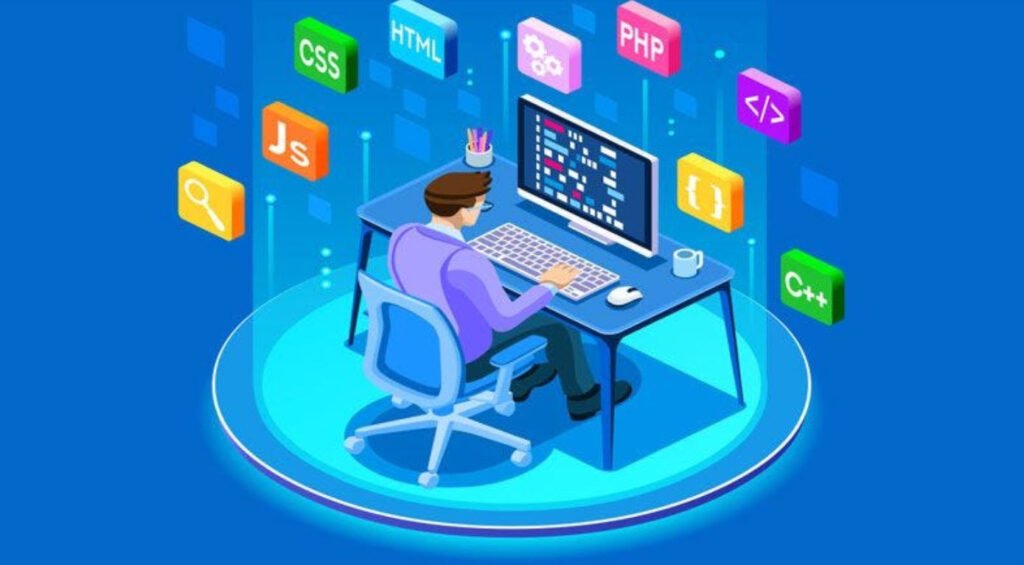In the rapidly evolving world of technology, Full Stack Developers have become invaluable assets to the software development industry. These versatile professionals possess a comprehensive skill set, enabling them to handle both front-end and back-end development tasks.
In this article, we will take you through a step-by-step guide on how to become a proficient Full Stack Developer.
- HTML: The Foundation of Web Development
- CSS: Adding Style and Aesthetics
- JavaScript: Adding Interactivity
- Git+GitHub: Version Control and Collaboration
- Build Project: Applying Your Skills
- React: Mastering Front-End Frameworks
- Node.js: Exploring the Back-End
- Build an API: Connecting Front-End and Back-End
- Build Project: Applying Back-End Skills
- Next.js: Server-Side Rendering
- CI/CD: Streamlining Development Workflow
- CockroachDB: Scalable Database Management
- Build Project: Showcasing Your Full Stack Skills
Step 1 – HTML: The Foundation of Web Development
HTML, or HyperText Markup Language, serves as the backbone of web development. It defines the structure and content of a webpage. Aspiring Full Stack Developers should start by learning the fundamentals of HTML, including elements, tags, and attributes. This step lays the foundation for creating web pages and understanding how different elements interact with each other.
Step 2 – CSS: Adding Style and Aesthetics
Cascading Style Sheets (CSS) is the key to adding visual appeal and design elements to your web pages. Learn how to manipulate layout, typography, colors, and responsiveness using CSS. Acquiring CSS skills will enable you to transform a plain HTML page into an engaging and user-friendly interface.
Step 3 – JavaScript: Adding Interactivity
JavaScript is a programming language that empowers you to add interactivity and dynamic features to your websites. Mastering JavaScript involves understanding concepts like variables, functions, loops, and events. You’ll learn how to create interactive forms, animations, and dynamic content, enhancing user experience.
Step 4 – Git+GitHub: Version Control and Collaboration
Version control is crucial for managing code changes, collaborating with other developers, and maintaining a clean codebase. Git, in combination with platforms like GitHub, allows developers to track changes, collaborate on projects, and manage code effectively within a team environment.
Step 5 – Build Project: Applying Your Skills
Put your HTML, CSS, and JavaScript knowledge to the test by building a small web project. This hands-on experience will solidify your understanding and boost your confidence as a developer. As you progress, consider incorporating Git for version control, ensuring that you are comfortable with collaborative development workflows.
Step 6 – React: Mastering Front-End Frameworks
React, a popular JavaScript library, simplifies the process of building user interfaces. Learn about components, props, states, and hooks, which are essential concepts for developing interactive and dynamic front-end applications. React’s component-based architecture enhances reusability and maintainability.
Step 7 – Node.js: Exploring the Back-End
Node.js enables server-side JavaScript development, allowing you to create scalable and efficient back-end services. Learn about asynchronous programming, modules, and the Node.js runtime environment. Understanding Node.js sets the stage for handling server-side logic and communication.
Step 8 – Build an API: Connecting Front-End and Back-End
Application Programming Interfaces (APIs) facilitate communication between different software components. Build a RESTful API using technologies like Node.js, Express, and MongoDB. This step will teach you how to structure data, handle HTTP requests, and create endpoints for data exchange between the front-end and back-end.
Step 9 – Build Project: Applying Back-End Skills
Combine your front-end and back-end knowledge to develop a full-stack web application. Integrate the API you built in the previous step with a front-end framework like React. This project will showcase your ability to create end-to-end solutions and handle data flow seamlessly.
Step 10 – Next.js: Server-Side Rendering
Next.js, a React framework, introduces server-side rendering for improved performance and SEO optimization. Learn how to build dynamic and server-rendered React applications, enhancing user experience and search engine visibility.
Step 11 – CI/CD: Streamlining Development Workflow
Continuous Integration (CI) and Continuous Deployment (CD) practices automate the process of code integration, testing, and deployment. Utilize tools like Jenkins, Travis CI, or GitHub Actions to establish an efficient and error-free development workflow.
Step 12 – CockroachDB: Scalable Database Management
CockroachDB is a distributed SQL database designed for scalability and resilience. Learn about database design, data modeling, and SQL querying. Understanding databases is vital for handling data storage, retrieval, and management in your applications.
Step 13 – Build Project: Showcasing Your Full Stack Skills
Cap off your journey by building another project that incorporates all the skills you’ve acquired. This comprehensive project should demonstrate your ability to create feature-rich, performant, and responsive web applications from start to finish.
Conclusion
Becoming a Full Stack Developer is a rewarding journey that requires dedication, continuous learning, and hands-on experience. By following this step-by-step guide, you can acquire the skills needed to tackle both front-end and back-end development tasks, ensuring you’re well-prepared for the dynamic and ever-changing world of software development.
Remember, the key to success is consistent practice and a passion for building innovative and user-centric applications.



